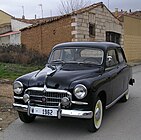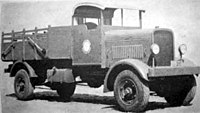Butale Automobile Works
This article is incomplete because it is pending further input from participants, or it is a work-in-progress by one author. Please comment on this article's talk page to share your input, comments and questions. Note: To contribute to this article, you may need to seek help from the author(s) of this page. |
Native name | Butale Tepozcamatetl Tequipanceh, TCT |
|---|---|
| Industrial calpolli group (tepohualoyan calpolleh tequipanyotl, TCT) | |
| Industry | Automotive |
| Founded | September 9, 1932 in Kaudwane, Pulacan |
| Headquarters | Kaudwane , |
| Products | Automobiles, automotive parts |
Production output | 427,092 units sold (2022) |
Butale Automobile Works (Nahuatl: Butale Tepozcamatetl Tequipanceh, TCT, commonly known as Butale) is a car manufacturer in Pulacan. The calpolli group was founded on September 9, 1932, in the town of Kaudwane. Originally developed as a means to reinvigorate Pulacan's postwar industry, Butale has grown to be the largest automotive industrial group in Pulacan. The company continues to produce vehicles to this day, both for the domestic market and for export across Malaio and the wider world. The group is known for finishing partly-assembled auto bodies and selling them on, usually as rebadges, as well as for manufacturing cars aimed at filling the low-cost and high-durability niches. To this day, Butale remains headquartered in Kaudwane. As of 2022, the company was producing 427,092 units annually, with 396,658 units being sold that year across dozens of countries.
History
Pulatec industry had been left in shambles in the aftermath of the Hanaki War. Much of its industrial buildup in the north had been destroyed, and what remained had been haphazardly repurposed for war production. Remaining civilian factories were few and far between, and were unable to provide enough output to return to pre-war levels. To set Pulacan back on track, Pulatec president Dumelang Tsogwane devised a scheme to use received war reparations, along with aid money and expertise from Zacapican, to finance rebuilding. Under this scheme, returning Pulatec soldiers would be offered jobs with government subsidies in work establishing industrial calpolleh; clan calpolleh on the edges of cities would similarly be given generous aid for establishing themselves as industrial calpolleh. One such clan that accepted the Tsogwane offer was the Butale clan living on the outskirts of Kaudwane. At the time, the city was provincial and impoverished, and the seat of power of a minor kgosi (chief). Only during the war had it received modern infrastructure when, in 1929, a narrow-gauge spur line was built to make the town into a secondary logistics hub in the defense network of the Djebe Highlands. This line would be repurposed during construction to transport goods in and out of the Butale plant.
Construction began on the plant by the end of 1932, and by 1933, rudimentary vehicles were already being manufactured. The first model produced was the Butale Machoh, a 4x4 utility truck. Given the lack of automotive infrastructure and the overarching need for vehicles to use in reconstruction, the Butale plant did not diversify into the passenger field until 1939 with its Butale 100 model. The 100 both established the trend of numbering Butale's model range and began the company's practice of creating simple, durable consumer vehicles for low costs.
Model range
Under license
Facilities
The majority of Butale's manufacturing work is done at the eponymous Butale Manufacturing Complex in Kaudwane.






